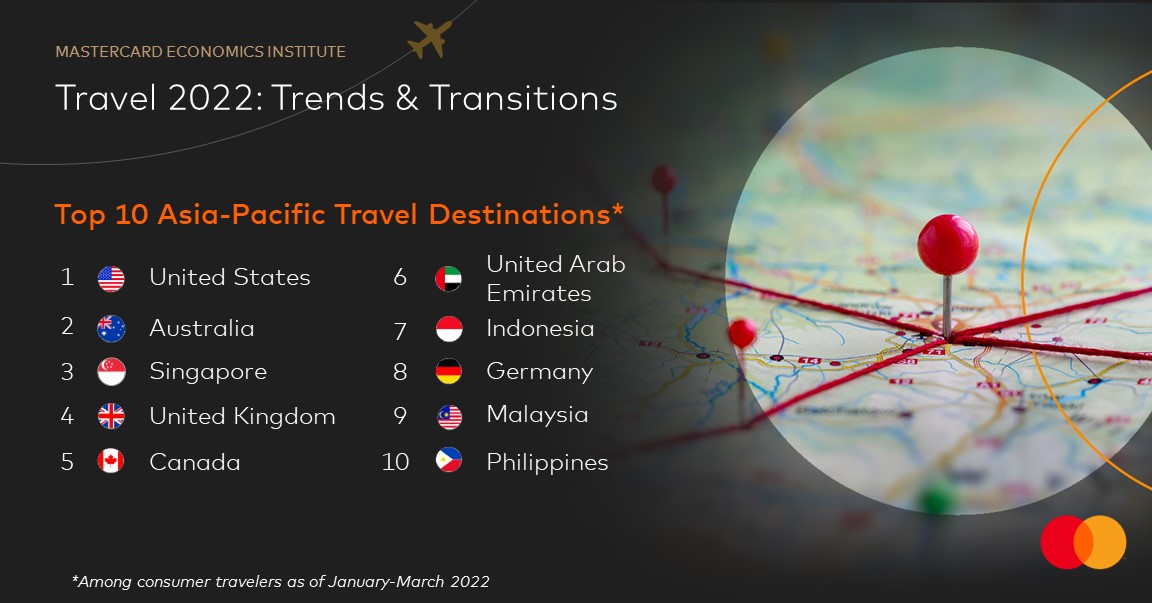ASIA PACIFIC. New research from the Mastercard Economics Institute reveals insights into the recovery of travel markets as restrictions ease and as demand surges.
The Travel 2022: Trends and Transitions report homes in on 37 markets across the globe, with particular focus on nine in Asia Pacific. The report states that for the first time since the pandemic, flight bookings worldwide are now surpassing pre-pandemic levels.
The report compares the current state of global travel to two key ‘inflection points’: the pre-pandemic levels of 2019, and trends from the period when border restrictions began to ease and international travel resumed across most geographies.

Key findings through April 2022 for Asia Pacific include:
- Reopening of borders puts Asia back on the tourist map: According to the Mastercard Economics Institute analysis, if flight booking trends continue at the current pace, an estimated 430 million more passengers will fly in Asia Pacific compared to last year. The travel outlook for the region is optimistic, even with markets across North Asia and Mainland China yet to relax border measures.
- Pent-up demand fuels travel recovery: Following two years of little to no travel for Asia Pacific in 2022, the loosening of travel restrictions and reopening of borders has sparked a surge in demand for both inbound and outbound travel. A trend observed in markets across the region is consumers’ release of excess savings on travel, notes the report. In 2022, borders opened in Australia, resulting in a sudden ability to travel. Flight bookings from Australia to Indonesia, for example, have spiked nearly +200% in 2022, and to the US the figure more than doubled.
- Travel spending swings towards experiences: Globally, for the majority of the year, international tourists were seen spending more on “experiences rather than things” when in destination, says Mastercard. This trend was also witnessed in Asia, where Singapore recorded one of the highest international tourist spending on experiences in destination globally, with a +60% increase in spending from pre-pandemic levels through March 2022. Other markets across the region, however, revealed a more mixed picture, with low levels of inbound tourism seen in Indonesia and South Korea, whose borders opened in April 2022.
- Choice of travel destinations influenced by restrictions: Since the onset of the pandemic, trends reveal that people have been favouring travel destinations that are less complex to navigate amid confusing entry and quarantine requirements, travel restrictions, and testing procedures. As such, the US remained the most popular choice for Asia Pacific travellers, followed by Australia, Singapore, UK, and Canada. In the months to come, notes the report, this trend is likely to shift in favour of intra-regional travel as restrictions are relaxed and domestic travel picks up once again.
- The cost of travel remains elevated: Travel deficits triggered by the pandemic have expanded the operating expense burden for airlines and the broader transportation industry, resulting in higher fares for travellers in Asia Pacific compared to their global counterparts. The average airfares in Asia Pacific remain elevated – roughly +11% and +27% above 2019 levels in Australia and Singapore respectively – due to supply-side constraints such as air transportation employment, which continues to remain below pre-pandemic levels across the region.
- Domestic spending picks up momentum: With people increasingly relying on domestic modes of transportation, particularly cars, for mobility during the pandemic, the spending on auto rentals and tolls consistently exceeded 2019 levels throughout the past two years. Domestic ground travel has seen a robust demand in many Asia Pacific markets where road trips have retained their appeal. Fuel spending has steadily increased in Singapore, Hong Kong, the Philippines, and Australia, while public transportation and cruise lines have also firmly stepped back onto the road to recovery, after an initial slow start due to restrictions surrounding group travel.

“Despite a delayed recovery, and numerous risks such as inflation impacting discretionary spending, travellers in Asia Pacific have demonstrated a strong desire to return to travel,” said David Mann, Chief Economist, Asia Pacific and Middle East Africa of the Mastercard Economics Institute.
“2022 will prove to be a significant year for the travel industry in Asia Pacific. As border restrictions relax we have witnessed an accelerated return to travel that indicates cause for optimism, with the region poised to swiftly catch up with the rest of the world.”
The 2022 Trends and Transitions report – the third in an annual series from the Mastercard Economics Institute – draws on analysis of publicly available travel data, as well as aggregated and anonymised sales activity in the Mastercard network.
It highlights the tailwinds propelling travel recovery, consumer considerations when making travel-related purchasing decisions, and macroeconomic trends such as inflation, hybrid work, healthcare risks, and geopolitical disruptions that could influence travel.
The full Travel 2022: Trends and Transitions report can be accessed via this link.









